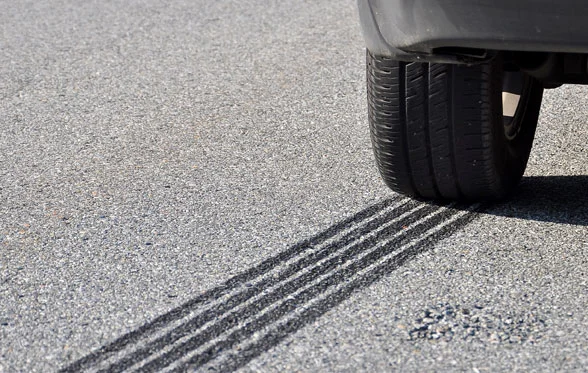After many months of discussion and negotiation, the new United Nations Economic Commission for Europe (UN ECE) requirements on tyre pressure monitoring systems were finally published on 10th November 2010. These new requirements have been published as an 02 series of amendments to ECE Regulation No. 64, which now covers temporary use spare wheels and tyres, run flat tyres and tyre pressure monitoring systems.
The need for agreed ECE requirements on tyre pressure monitoring systems was generated by the European Union when they published Regulation (EC) No. 661/2009 on general safety which mandated the fitment of tyre pressure monitoring systems for M1 category vehicles from 1st November 2012 for new types of vehicle. The European Union justified this mandatory requirement for tyre pressure monitoring systems on the grounds of both safety and environmental protection, as the loss of pressure in one or more tyres affects both the vehicle's handling characteristics and its fuel consumption/CO2 emissions.
Initial drafting of the ECE requirements was based on the pre-existing US legal requirements on tyre pressure monitoring systems contained in FMVSS 138. However, within the relevant group of experts, there was much discussion and negotiation over the thresholds at which the tyre pressure monitoring system should activate. Some of the experts proposed that the tyre pressure monitoring system should activate when the tyre pressure drops to 20% below its recommended inflation pressure, whereas other experts, notably those representing the vehicle manufacturers, thought that 20% was too severe and recommended a value of 25%. The vehicle manufacturers were concerned that, due to natural variations in the tyre inflation pressure that occur due to ambient temperature and the inherent tolerances in the pressure sensing equipment, a threshold of 20% could lead to the system being too sensitive and providing "false warnings". These "false warnings" could prove to be an annoyance to the driver and may even result in the driver ignoring the warnings.
The finally agreed requirements, which apply to the tyre pressure monitoring systems of both M1 and N1 category vehicles, specify that the system must give a warning when the tyre pressure in one or more tyres drops to 20% below its recommended inflation pressure, but allow an additional 5% tolerance to be applied to the tyre pressure measurements observed during the type approval tests.
The new requirements introduced into ECE 64.02 also include detailed technical requirements on the tyre pressure monitoring system (e.g. warning indication, malfunction detection, etc.) and test procedures for determining compliance with the technical requirements.
Although ECE 64.02 does not mandate the fitment of tyre pressure monitoring systems itself, it allows Contracting Parties to mandate compliance with these new requirements from 1st November 2012 for new types of vehicle and from 1st November 2014 for all new vehicles.
Aug 2025
New Chinese Standard on Onboard Accident Emergency Call Systems PublishedJul 2025
The National Highway Traffic Safety Administration and the Federal Motor Carrier Safety Administration Publish Significant Number of Notices of Proposed RulemakingJun 2025
New UN ECE Regulation on Acceleration Control for Pedal Error PublishedMay 2025
Draft Euro 7 Emissions Implementing Regulations PublishedApr 2025
Amendments to EU Regulation on Heavy Vehicle CO2 Emissions Determination PublishedMar 2025
The National Highway Traffic Safety Administration (NHTSA) Issue a Final Rule (FR) for two new Federal Motor Vehicle Safety Standards (FMVSSs) for Hydrogen Powered VehiclesDec 2024
Updated Chinese Standard on the Fuel Consumption Limits for Heavy Duty Vehicles PublishedNov 2024
The National Highway Traffic Safety Administration (NHTSA) Issue a Notice of Proposed Rulemaking (NPRM) regarding Pedestrian ProtectionOct 2024
New UN ECE Regulation on Driver Control Assistance Systems PublishedSep 2024
The National Highway Traffic Safety Administration Issues Advanced Notice of Proposed Rulemaking to Revise Federal Motor Vehicle Standard 207 for SeatingAug 2024
The National Highway Traffic Safety Administration (NHTSA) published a Supplemental Notice of Proposed Rulemaking (SNPRM) to amend the NHTSA regulations to include an advanced crash test dummyJul 2024
Updated UN ECE Regulations Relating to Hydrogen Fuelled Vehicles PublishedDec 2023
EU Regulation on Advanced Driver Distraction Warning Systems PublishedNov 2023
Updates to Australian Design Rule on Side Impact ProposedOct 2023
The NHTSA Issue a Proposal to Amend Anthropomorphic Test DevicesSep 2023
The Consumer Product Safety Commission (CPSC) Issues a Proposal to Amend Consumer Product Safety Standard for Four-Wheel All-Terrain Vehicles (ATVs)Aug 2023
Draft EU Regulation on Recyclability and End of Life Vehicles PublishedJul 2023
The National Highway Traffic Safety Administration (NHTSA) Issued a Proposal to Add a New Federal Motor Vehicle Safety Standard (FMVSS) to Require Automatic Emergency Braking (AEB) for Light VehiclesDec 2022
Draft EU Regulation on Euro 7 Emissions Requirements PublishedNov 2022
Updates to UN ECE Regulation on Hydrogen Fuel Systems PublishedOct 2022
The Department of Transportation (DOT) Issued a Request for Information (RFI) Enhancing the Safety of Vulnerable Road Users at IntersectionsSep 2022
Scope of EU Regulations on Heavy Duty Vehicle CO2 Emissions ExpandedAug 2022
NHTSA Issue a Notice of Proposed Rulemaking (NPRM) Regarding Event Data Recorders (EDRs)Jul 2022
Updates to the EU Regulation on Heavy Duty Vehicle Emissions Proposed to Cover Vehicles using Pure BiodieselDec 2021
EU Regulation on Intelligent Speed Assistance Systems PublishedNov 2021
EU and UN ECE Develop New Regulations on Event Data RecordersOct 2021
The Environmental Protection Agency (EPA) Proposed New Rule to Revise 2023 and Later Model Year Light-Duty Vehicle Greenhouse Gas (GHG) Emissions StandardsSep 2021
EU Regulation on Driver Drowsiness and Attention Warning Systems PublishedAug 2021
Two New ECE Regulations to Protect Vulnerable Road Users PublishedJul 2021
Draft EU Regulation on Type Approval Market Surveillance Requirements PublishedStay Updated on Vehicle Regulations
Get the InterRegs Update Bulletin — a free monthly email with the latest global vehicle regulation news and updates.
If you want to keep up to date with our latest spotlight articles you can subscribe to their dedicated feed with your RSS reader of choice.
